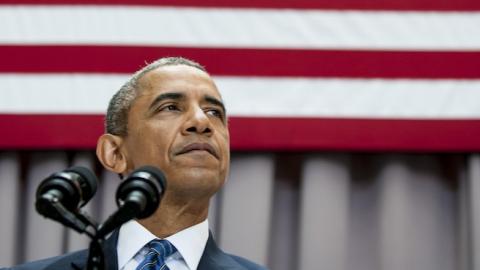A day after the deal with Iran over its nuclear program was implemented in January, the Obama administration paid $1.7 billion to Iran to settle an old Iranian claim (unfinished business from the 1970s). At the same time, the Islamic Republic released four Americans it held in prison. The timing was striking: It looked an awful lot like a ransom payment. But the White House denied it. Last week, the Wall Street Journal published further details, which make it all but impossible for any reasonable observer to deny that the White House paid off the regime in Tehran in exchange for the liberty of U.S. citizens: The first installment of $400 million, we now learn, came in cash.
According to the Journal report, “Wooden pallets stacked with euros, Swiss francs and other currencies were flown into Iran on an unmarked cargo plane." Foreign currencies were used because transactions with Iran using U.S. dollars are illegal under American law. As Charles Krauthammer remarked, if a company was caught laundering money like this, the CEO would go to jail. Even worse, the massive cash transfer would be especially helpful in funding the clandestine activities of a state sponsor of terrorism. A cargo plane full of currency sounds like the opening scene in a great spy thriller. Except it's not. It's the Obama administration paying off a regime that has been kidnapping and killing Americans for all 37 years of its existence.
The White House is pushing back against the Journal report. It's a story "for those who are flailing in an attempt to justify their continued opposition to the deal to prevent Iran from obtaining a nuclear weapon," said White House spokesman Josh Earnest. "The United States," he continued, "does not pay ransoms."
Except when it does. And the Obama administration obviously did. Hostage-taking is a key instrument of Iranian statecraft. Tehran has found it useful for its adversaries to understand that it is willing to violate international political and diplomatic norms to have its way. Attacking embassies, as the Iranians trashed two Saudi diplomatic facilities this winter, even predates the habits of the revolutionary regime: In 1829, Tehran mobs surrounded the Russian embassy and killed the ambassador. One hundred and fifty years later, revolutionary gangs overran the U.S. embassy and held 52 Americans hostage for 444 days.
It's simply how the Iranians do things. Hezbollah, Iran's praetorian guard in Lebanon, took plenty of Americans and other nationals hostage in Beirut in the 1980s. In order to free them, the Reagan administration gave weapons to Iran, Hezbollah's patron. Everyone knows it's a bad idea to pay for the release of hostages, since it creates a market in taking more. And, indeed, the Iranians have "jailed" two more Americans since the January exchange.
What distinguishes the January planeload of cash is that the Obama administration paid ransom not simply for the freedom of American citizens but also to preserve the president's signature foreign policy initiative. The vaunted Joint Comprehensive Plan of Action turns out to be the culmination of a hostage negotiation.
Let's look at the details. Administration spokesmen argue that the $400 million paid out was Tehran's money to begin with. But that's not true. The $400 million was a payment received from the shah of Iran for a weapons deal with Washington that was never consummated because he was toppled by the Islamic revolution in 1979. Thus Washington held the money. Later, American victims of Iranian terrorism won judgments against the Islamic Republic in U.S. courts, and the Clinton administration, as a Newsweek article reported in January, promised that the settlements would be paid out of the $400 million. But the Clinton White House never reimbursed the Treasury Department, nor did the Bush administration. The $400 million that Obama aides say belongs to Iran should have long ago been distributed to Iran's American victims and their families. Instead, it was U.S. taxpayers who compensated the victims of Iranian terror. And then we paid $400 million a second time, in January, to the Iranians themselves. The $1.3 billion of interest that the United States is supposed to have owed the Iranians is simply a fiction the Obama administration contrived to sweeten the pot, since the United States was under no legal obligation to pay Iran money that was no longer Iran's. Yes, it was ransom, billed to the U.S. taxpayer.
The Obama administration has never shown much interest in compelling the Iranians to abandon their habit of taking hostages. Quite the opposite, in fact. The administration built its Middle East policy around the idea that it was hostage to Iran. America's military options against Iran and its regional proxies were limited, said White House officials, by the fact that the United States had thousands of troops in Iraq and Afghanistan for Iran to target. In other words, in the administration's view, the American military was held hostage by Iran. U.S. allies were also constrained since Iran would take it out on those same American troops if, say, Israel decided to take action against Iran.
Since Iran had America cornered, the only option, argued the White House, was the nuclear agreement. Sure, it wasn't perfect, but it was better than war with Iran. In time, the administration moved the goal posts so far that even sanctions were said to be likely to lead to war. But if the president of the United States had taken military force off the table, who could possibly be threatening war? Only Iran. The administration's message was that if Americans didn't want war with an Iran ready to make war, we had no choice but to sue for peace and pay up. The nuclear deal wasn't ideal—we conceded on everything from uranium enrichment to inspections—but it was better than war.
The Obama administration used Iran's reputation as a state that pays no heed to international norms—kidnaps civilians, overruns embassies, backs terror—to push the nuclear deal. In warning critics of the JCPOA that their opposition would lead to war, the White House effectively cowrote Iran's ransom demands.
A year after the deal was signed and more than six months after implementation day—and the hostage deal—the White House's talking points are sounding ever more hollow. The self-anointed party of science seems to have a difficult time coping with the idea of empirical evidence. Critics of the deal are not genetically opposed to any accommodation with Iran ever. Rather, they understand that even a casual glance at the facts shows this regime is not yet ready to be ushered back into the community of nations.
And then there's the administration itself, which struck an agreement over a nuclear weapons program with a regime that at the very same time gave clear evidence that it has no interest in abiding by international norms. The empirical evidence is that the clerical regime in Tehran cannot be trusted, and the Obama administration will continue to provide cover for it. No price is too high to pay if it preserves the president's signature foreign policy initiative.
















